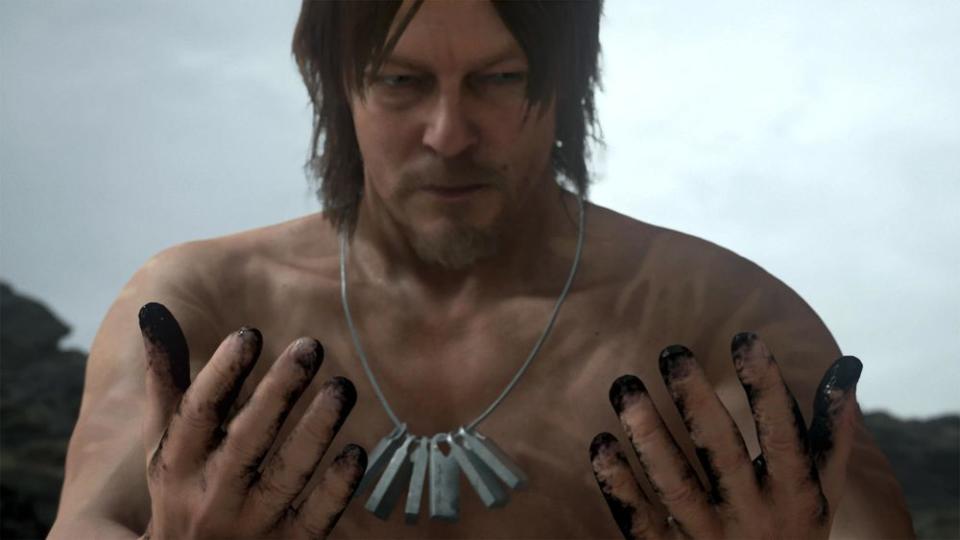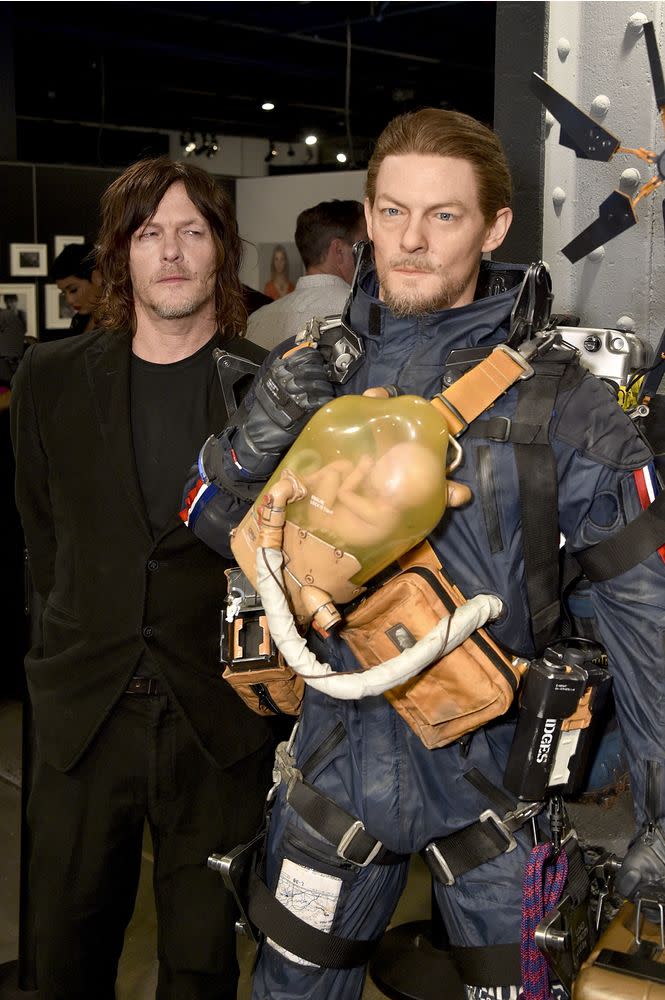How Death Stranding with Norman Reedus bridges the gap between videogames and cinema
When Hideo Kojima, the prolific game-maker behind the Metal Gear Solid series, was a boy, he had a vision of what the 21st century would look like. “There would be no war, no poverty. It would be like Star Trek. All the world would be like one.” He recalls this, through a translator, backstage at a Manhattan gallery, the site of a one-night art exhibition showcasing all the concept illustrations that went into his latest project, Death Stranding. “That’s what it was supposed to be.” Obviously, we never reached that future, but Kojima and his videogames have become considerably better at tapping into the cultural and political zeitgeist before anyone else.
In 2017, players were convinced Kojima had predicted their current reality through the story of Metal Gear Solid 2, released about 16 years prior. A scene between the characters of Raiden and The Colonel from this gaming franchise took off online at the time, way before “Fake News” became a rallying chant for the current sitting president. Kojima’s characters remark how “trivial information is accumulating every second” in this “digitized world” that also “selectively rewards development of half-truths.”
Now, in 2019, the cast of Death Stranding believe Kojima again “connected” — a word they use quite often in trying to describe the videogame — with something entirely new. “It’s not a kill-them-all, be-the-last-one-standing game,” says The Walking Dead‘s Norman Reedus, who portrays the star character, Sam Bridges. “The whole point is to connect and you have to fight to get there and you have to grow as a person. You have a billion people all doing that at the same time. That’s going to do some good, and I think now, especially, is a good time for that to happen.” The extent of Mads Mikkelsen‘s videogame knowledge prior to Death Stranding started and ended with Space Invaders. (Like, the original Space Invaders.) But, for the Hannibal veteran, who portrays an antagonist to Sam named Cliff, Kojima’s new world “has persuaded me to start over and recapture some of my lost game play.”
The presence of these Hollywood actors in a game that also features roles for Oscar-winning director Guillermo del Toro, James Bond actress Léa Seydoux, The Leftovers‘ Margaret Qualley, and The Bionic Woman herself Lindsay Wagner already gives players some idea of what Death Stranding is. Each delivered voice roles and motion-capture performances to bring their characters to life, but Death Stranding is definitely not a film. It’s also not entirely a videogame, at least in the traditional way that we’ve come to think about videogames.
One word seems to come up repeatedly when trying to describe the experience: “connection.”

In the story, Reedus’ Sam is a “porter.” In other words, a delivery man. Sam traverses America for a company called Bridges, transporting packages and supplies to a now-disconnected civilization. In this world, beings from the space between life and death — called BTs for “beached things” — entered the world during the Death Stranding. Most of humanity walled themselves off inside their respective cities to stop from being consumed by the Death Stranding and becoming BTs. It becomes Sam’s job to travel across what remains of the Land of the Free to connect everyone again through the same online network.
There are also obstacles at play, like “Timefall,” which is rain that vastly accelerates the aging process of whatever it comes into contact with. (A single drop can mean unconcealable wrinkles.) There are also elements like “BBs” (for “bridges babies”), infants with a connection to the other side that are farmed and used to help porters to see and detect the presence of BTs.
“I didn’t really know exactly where my part fit into the whole picture,” Mikkelsen says of the first few conversations with Kojima about the game. Playing through about 4 hours of Death Stranding, the feeling is understandable. Through Sam’s BB, we see flashes of memories of Cliff before he shows up later in a more sinister form.
A filmmaker friend advised Mikkelsen to become a part of Death Stranding, Nicolas Winding Refn, who directed the actor in Valhalla Rising and also plays a different character in the videogame. “It was like a graphic novel, and I’m a big graphic novel fan,” Mikkelsen notes of seeing early concept art designs. “I had a hunch that I really wanted to be a part of that process.”
Reedus had a similar experience: “Guillermo del Toro originally called me and goes, ‘There’s a guy that’s gonna contact you to be in a game that we’re making. Say yes.’ I was like, ‘What do you mean say yes?’ He’s like, ‘Trust me.’ Guillermo got me my first acting job. I have a huge respect for our friendship. I know if someone presses Guillermo that much, I’m going to love him.”
Such a complex and layered story like Death Stranding stems from Kojima’s personal struggles. Following his tenure developing titles for Japanese gaming company Konami, he set out to construct his own studio, what we know now as Kojima Productions. “[Death Stranding] was about the days when I was going independent and had nothing,” Kojima explains. “I was like, ‘I want to make something.’ I only had dreams and hope, I didn’t have anything around me to start.”
In 2016 at the E3 gaming expo, where studios and developers gathered to preview their upcoming releases, Kojima first announced Death Stranding as his next project and his sense of isolation broke. “I found out there were already fans and I had connected with fans,” he says. Those connections also extended to Sony Interactive Entertainment, which now partners with Kojima Productions on Death Stranding, as well as Del Toro, who was working with Kojima on the now-canceled P.T. Silent Hills videogame. “When I tried to lead all these connections together, I thought I would make a game based on connection.”
At the same time, it’s almost “a sarcasm to connect,” he adds. In the real world, technology tends to isolate users; people feel more concerned with the life of their social media personas than their actual lives, while text messaging and anonymous comments online often replace in-person conversations. In Death Stranding, technology becomes a way to bring people together. For instance, if one player builds a ladder to climb up a mountainside or a bridge over a stream, another player can utilize those same structures. The game actually encourages players to pay it forward — even if some are doing so to selfishly make their own lives easier.
“I’m not saying yes or no to connection. The answer is up to the players to think about,” Kojima says. “If you play the game, you may feel a connection is not bad after all. So what I wanted to say in Death Stranding is the fact that we’re isolated using the state of our internet, but don’t deny the technology that we have. It’s how you use the technology.”
Kojima leads by example in the way he uses the technology at his disposal. His efforts with motion-capture, by no means a new concept to the Hollywood engine, bring more realism to his characters. At times, it’s too realistic; one function allows players to make Sam urinate where he stands. (Really!) On the opposite end of that spectrum of signature Kojima weirdness, the mastermind personalized the characters to the actors. When he saw Mikkelsen taking a smoke break during one of their filming sessions, he programmed the actor’s character to smoke in the game. “I don’t think I did something really new here,” Kojima notes. “Performance capture is something that was there [already]. I’m just using in a different way.”

The results bring a more cinematic experience to Death Stranding that Kojima, too, takes advantage of. There are your standard easy, medium, and hard levels of difficulty for players to choose from, but there’s also a very easy setting designed with cinema lovers in mind.
“When I announced [Death Stranding], I got responses like, ‘I’m a great movie fan and I saw your game, but I haven’t been playing games,'” Kojima recalls. “I wanted to set the bar really low and that’s the very easy mode. All of these people that are movie fans, they say games nowadays are just so complicated they can’t do it anymore… I want people to come back to playing games again. It’s totally different than watching a movie. It’s basically easy, but you have to control it. You’re not just watching it.”
Though he’s interested in one day tackling a movie of some kind, it’s important for Death Stranding to exist as a videogame. The nature of choice lends itself to the idea of connection. (There’s that word again.) “If it’s a movie you just see the character connecting, it’s not you,” Kojima continues. “Everyone who sees the movie could watch it from a little bit of a distance, but in the game it’s interactive. You’re the one deciding and you’re the one connecting.”
Following this same idea strand, Kojima is now looking ahead to streaming for some future project. Well, specifically, the intersection between streaming and A.I. technology. The man is fascinated with the thought of what he predicts will be “a wave of creating things” stemming from artificial intelligence. He says, “I want to do something really weird or something unique on the streaming platform. Technically, I’m trying to experiment already.”
Kojima has a lot of ideas bouncing around in his mind. When asked about turning Death Stranding into another series of games like Metal Gear Solid, he mentions, “It should probably be done, but I don’t know about my whole schedule and my physical condition, too.” Still, he keeps coming back to streaming, if only because, with so much content available on streaming platforms “there are a lot of things in between [a movie and a game] you cannot define.”
Coming from a film and television background, Mikkelsen is intrigued by the potential of interactive storytelling. “The whole idea that people can go in and be a part of the story themselves, it’s probably not something that’s going to happen in the movie industry for a number of years, but it’s definitely something that will be on the table somehow, working together with the gaming world and the film world,” he says. “I think there’s definitely a future to that.”
Black Mirror: Kojima, anyone?
Related content:

